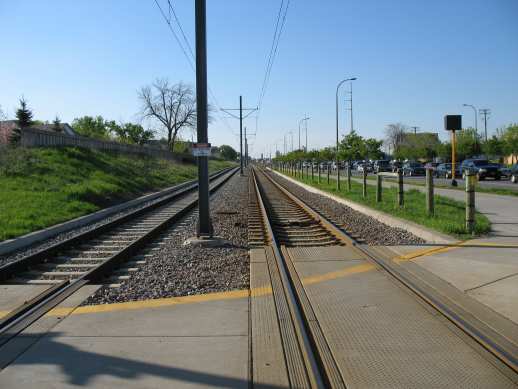
A recent comment I received on this blog made me think about how experienced cyclists maneuver their bikes to control and interact with cars around them. The commenter had a problem when trying to cross railroad tracks which were at an angle to the road. The road in question was very narrow.
To cross the tracks at a 90° angle, he had to ride from the right-hand side of the road into the middle of the lane. As he concentrated on not catching his narrow tires on the tracks, he didn’t hear a car approaching from behind. Fortunately, the car blew its horn to alert him and managed to stop in time to avoid hitting the cyclist.
Stories like this are common. Many cyclists have had their attention drawn away from the traffic when trying to avoid an obstacle in the road. This is one of the pitfalls of sharing the road with cars, and although it can happen to anyone, it is more likely to be a problem for inexperienced cyclists.
Most people learn to ride a bike as kids. They are taught to balance the bike while pedaling and to steer it in the direction they want to go. During their childhood, these are the only skills they need to use their bikes.
Sometime later, as they approach or reach adulthood, bicycles take on a new meaning. They can be used for recreation or transportation to work or school. This is when the problems begin.
Few people are taught to ride bicycles in traffic. Despite educational programs in the past and present, which teach people to ride a bike like a car, there hasn’t been much emphasis on how cars and bikes differ when using roads.
The biggest differences lie in the difficulties potholes, debris and obstacles cause for a bicycle versus a car, the maneuvering required for a cyclist to make him/herself visible, and the need to avoid getting doored when passing parked cars. To address these problems, a bicycle cannot, and must not, act like a car.
Individual cyclists have different styles of addressing such problems, but the underlying principles remain the same: when riding in traffic, it is necessary to maneuver a bicycle to control cars. To accomplish this, cyclists must acquaint themselves with what certain roads have in common. For instance, urban roads often contain cars parked along the road. Traffic can be heavy, and cars jockey for position to turn and change lanes.
Riding in an urban environment takes knowledge, skill, finesse, and above all, anticipation. In fact, anticipation is the key to interacting with cars in a way that enhances a cyclist’s safety.
Familiarity with a particular road can also help. Knowing that a road narrows or leads into a blind curve can allow a cyclist to plan ahead. Gradually positioning oneself in the center of a lane, with the intent of slowing traffic or moving cars away from one’s bicycle, can reduce the odds of an accident.
Unless there are no cars parked along a road, an urban cyclists should always ride in the center of a lane to avoid getting doored. While blowing horns, under these circumstances, are typical, experienced cyclists will not let the noise force them to the right-hand side of the road. It’s important to learn to hold one’s ground and not to give drivers the impression that they can use aggression to intimidate cyclists off of the road.
Sudden moves should be avoided. Although there are times when something unexpected causes a cyclist to swerve or change course, such maneuvers should be few and far between. Road cycling is an activity which requires grace and agility. All movements should be as coordinated as possible so that drivers know what to expect from a cyclist.
The same holds true on suburban and rural roads, although the presence of parked cars is less frequent. Reduced traffic can lure a cyclist into a sense of false security. While the value of alertness would be obvious when amid the chaos of urban roads, it is often abandoned on long open stretches. And, this is where inattention can be most dangerous.
When only a few cars travel on a road, the bouts of silence in-between cars can make it harder to hear a single car approaching. This shouldn’t be too much of a problem if there is a shoulder to ride on. But, when a road has either a small shoulder, or no shoulder at all, cyclists must position themselves to control approaching cars. Moving into the center of the lane — although it may seem counter-intuitive — is the best way to avoid surprises, particularly on unfamiliar roads.
Taking the lane will force approaching cars to slow down. They will either have to move into the next lane, or wait for a break in oncoming traffic to pass the cyclist. Novice cyclists are sometimes afraid to take this tack for fear of being struck from behind. A rear end collision is far less common than a collision caused by a cyclist swerving into the center of a road to avoid an obstacle.
Fear can be reduced by listening closely to traffic and preparing oneself to interact with an approaching car. A quick glance over the left shoulder can provide information on how fast the car is approaching, and where it is positioned. On a two lane road, a cyclist can move slightly to the right of center to accommodate a car which is following too closely, and which seems unable to pass. Cooperation is the key to safety in such situations.
Overall, cyclists must understand both the similarities and differences bicycles and cars face when sharing the roads. A cyclist is always more vulnerable than a driver and must take that into consideration when maneuvering through traffic. However, adjusting one’s position as early as possible is the secret to using a bike to control the flow of traffic to the cyclist’s advantage.



